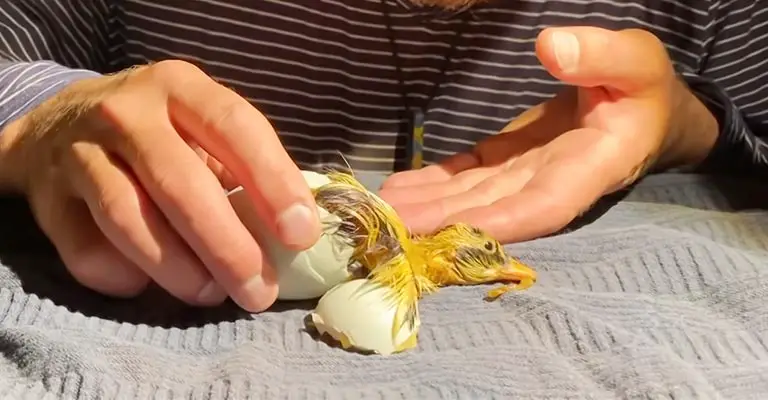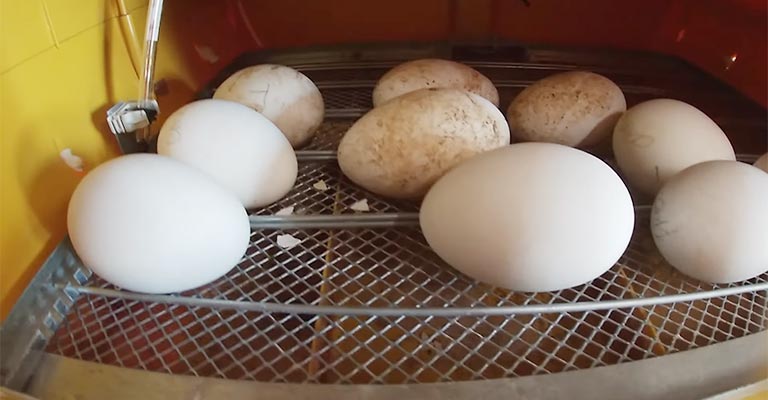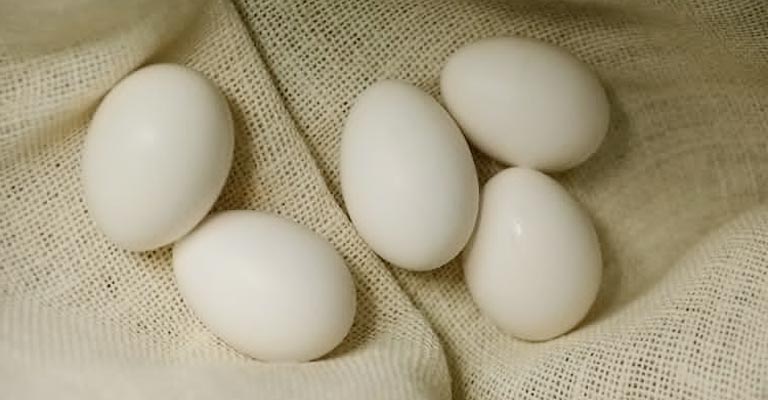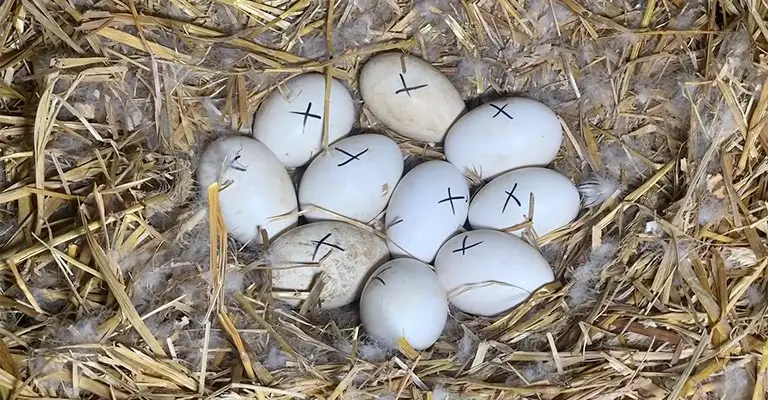Hatching goose eggs without the aid of an expensive incubator might seem like a daunting task, but with the right knowledge and some dedicated effort, it’s entirely possible.
Whether you’re a backyard farmer or just curious about the fascinating process of incubating eggs, this guide will walk you through the essential steps to how to hatch a goose egg without an incubator.
In the following paragraphs, we will explore natural and alternative techniques for hatching goose eggs, such as broody hens, surrogate geese, or homemade incubators.
You’ll learn about the necessary equipment, temperature and humidity control, and egg-handling procedures to increase your chances of a successful hatch.
With a little patience and the right approach, you can experience the wonder of witnessing a goose egg transform into a fluffy gosling right before your eyes, without the need for a high-tech incubator.

How To Hatch a Goose Egg Without an Incubator?
Before you embark on the journey of hatching a goose egg without an incubator, it’s crucial to gather the necessary materials and equipment. Here’s what you’ll need:
Start with a fertile goose egg. Ensure it’s clean, undamaged, and free from cracks. A broody hen or a surrogate goose will provide the necessary warmth and humidity required for egg incubation.
Prepare a quiet and secure nesting area for the broody hen or surrogate goose. Provide nesting materials such as straw or hay for insulation and comfort. A reliable thermometer to monitor the temperature in the nesting area.
A hygrometer to measure and maintain proper humidity levels. A candle or light source to check the development of the embryo within the egg.
Selecting the Broody Hen or Surrogate Goose
Choosing a suitable broody hen or surrogate goose is the first and most crucial step in hatching a goose egg without an incubator.
Look for a hen or goose that exhibits broody behavior, such as sitting on eggs, plucking her breast feathers, and displaying protective behavior. These signs indicate that she is ready to incubate eggs.
Preparing the Nesting Area
Create a secure and comfortable nesting area for your broody hen or surrogate goose. Ensure it’s located in a quiet, sheltered place to minimize disturbances. Line the nesting area with clean straw or hay to provide insulation and a soft bed for the bird.
Collecting and Storing Goose Eggs
Before placing the goose egg under the broody hen or surrogate goose, it’s essential to store it properly. Collect goose eggs daily and store them in a cool, dry place. Avoid storing them in the refrigerator, as this can affect their viability.
The ideal storage temperature is around 55-60°F (13-16°C), with a humidity level of about 75%.
Monitoring Temperature and Humidity

Proper temperature and humidity control are crucial for successful goose egg incubation.
The temperature should be around 99.5°F (37.5°C), and the humidity should be maintained at approximately 50-55% during the incubation period. Regularly monitor these conditions using a thermometer and hygrometer.
Egg Placement
Once your broody hen or surrogate goose is displaying broody behavior and the nesting area is prepared, carefully place the fertile goose egg beneath her.
Ensure the egg is positioned with the same orientation it had when it was first laid. Mark the egg with a pencil or marker to distinguish it from other eggs in the nest, as the broody bird may continue to lay more eggs.
Turning and Rotation
In nature, birds instinctively turn and rotate their eggs during incubation. If using a broody hen, she will likely do this naturally.
However, if you’re using a surrogate goose, you may need to gently turn and rotate the egg several times a day to ensure even heat distribution and proper embryo development.
Candling the Egg
Candling is the process of using a light source to examine the egg’s contents. It helps you determine the egg’s fertility and the embryo’s development.
To candle a goose egg, simply take it out of the nest and hold it up to a strong light source in a dark room. You should be able to see the embryo’s development through the eggshell. Candling should be done after the first week of incubation.
Egg Maintenance

Throughout the incubation period, check the egg regularly for any signs of damage or contamination. Remove any eggs that appear to be damaged or infertile to prevent them from affecting the other eggs in the nest.
Patience and Waiting
Hatching a goose egg without an incubator requires patience. The incubation period for goose eggs is approximately 28-34 days, so be prepared for a relatively long wait.
During this time, ensure the broody hen or surrogate goose is undisturbed and has access to food and water nearby.
Post-Hatching Care
Once the gosling has hatched, it’s essential to provide a warm and safe environment. Make sure the gosling is dry and fluffy before transferring it to a brooding area with a heat lamp or other heat source.
A temperature of around 95-100°F (35-38°C) is suitable for newly hatched goslings. Provide fresh water and starter feed designed for waterfowl.
Hatching goose eggs without an incubator can be challenging, and not all eggs will successfully hatch. Some common challenges include:
- Infertility: Not all eggs are fertile, so candling helps identify infertile eggs early in the incubation process.
- Poor Hatch Rate: Depending on various factors, your hatch rate may not be as high as with an incubator.
- Contamination: Contaminated eggs can lead to unsuccessful hatching. Regularly check for any signs of contamination.
- Temperature and Humidity Fluctuations: Maintaining consistent temperature and humidity can be challenging without an incubator.
How Long Can a Goose Egg Survive Without Heat?

Goose eggs, like many other bird eggs, can survive for a certain amount of time without heat, but the duration can vary based on several factors.
The egg’s ability to withstand temperature fluctuations largely depends on its stage of development, ambient temperature, and humidity levels. Let’s explore how long a goose egg can survive without heat and the factors that influence its viability.
Stage of Development
The stage of development of a goose egg is a critical factor in determining how long it can survive without heat. Goose eggs go through an incubation period, during which they require consistent warmth for proper embryonic development.
The incubation period for goose eggs typically ranges from 28 to 34 days, depending on the specific goose species.
Early Development (First Week)
During the initial week of incubation, goose eggs are less sensitive to temperature fluctuations. If an egg is left unattended in a cooler environment during this stage, it may have a higher chance of surviving for a longer period without heat.
Mid-Development (Second and Third Weeks)
As the embryo inside the egg continues to grow, it becomes more sensitive to temperature changes. Goose eggs in this stage require more consistent warmth for successful development.
Late Development (Last Week)
In the final week of incubation, the embryo is very developed and sensitive. Any extended period without adequate heat can significantly reduce the egg’s chances of hatching.
Ambient Temperature
The ambient temperature of the environment plays a significant role in determining how long a goose egg can survive without heat.
If the ambient temperature is relatively warm and stable, the egg can tolerate longer periods without artificial heat. Conversely, if the surroundings are cold or experience significant temperature fluctuations, the egg’s viability is compromised.
Warmer Environments
In a warm environment with temperatures within the range of what the egg requires for incubation (around 99.5°F or 37.5°C), a goose egg can survive longer without artificial heat. This is because the egg is less likely to cool rapidly.
Cooler Environments
In cooler environments, the egg will cool more quickly, which can negatively impact its viability. As the temperature drops, the egg’s metabolic processes slow down, and the embryo’s development can be delayed or halted.
Humidity Levels
Humidity is another crucial factor. Goose eggs require a certain level of humidity to maintain proper moisture content.
While the absence of heat can affect humidity to some extent, if the egg is in an environment with adequate natural humidity, it may have a better chance of survival.
Low Humidity
Low humidity can cause the egg to lose moisture too quickly, potentially leading to dehydration and reduced viability. Goose eggs require consistent humidity levels to remain viable.
Adequate Humidity
In an environment with relatively stable humidity, the egg can maintain its moisture content, which is crucial for the development of the embryo. Adequate humidity levels are essential for the egg to survive without heat for an extended period.
Egg Handling
How the egg is handled and stored during its time without heat can also influence its viability. Eggs should be handled with care to avoid any damage. Cracks or punctures in the eggshell can allow pathogens to enter, causing contamination and affecting the embryo’s health.
FAQs
How long can a goose egg survive without heat?
A goose egg’s ability to survive without heat depends on its stage of development, ambient temperature, humidity levels, and handling. In the early stages, it can tolerate cooler temperatures for a longer time.
Can I use a broody chicken to hatch goose eggs?
Yes, you can use a broody chicken to hatch goose eggs. Broody hens exhibit the natural instinct to incubate eggs. Place the goose eggs under a broody hen, and she will provide the necessary warmth and incubation care.
What are the ideal temperature and humidity levels for hatching goose eggs?
The ideal temperature for hatching goose eggs is approximately 99.5°F (37.5°C). Humidity levels should be maintained at around 50-55% during the incubation period.
How can I tell if a goose egg is fertile and developing?
You can determine if a goose egg is fertile and developing through a process called candling. To candle an egg, hold it up to a strong light source in a dark room.
What are the common challenges when hatching goose eggs without an incubator?
Hatching goose eggs without an incubator can present several challenges, including infertility, a lower hatch rate compared to using an incubator, the risk of contamination from damaged eggs, and difficulties in maintaining consistent temperature and humidity levels.
Conclusion
Hatching a goose egg without an incubator is a rewarding and educational endeavor that allows you to experience the miracle of life firsthand.
This DIY approach can be a cost-effective alternative for small-scale farmers or those who simply want to try their hand at incubating eggs without the need for expensive equipment.
Throughout this guide, we’ve explored various methods, from using broody hens to creating homemade incubators, and we’ve emphasized the importance of maintaining optimal temperature and humidity conditions during the incubation period.
By following the guidelines and gaining practical experience, you can increase your chances of successfully hatching a goose egg without the traditional incubator.
Remember, nature has its own way of nurturing life, and with your care and dedication, you can witness the incredible transformation of an egg into a lively gosling.